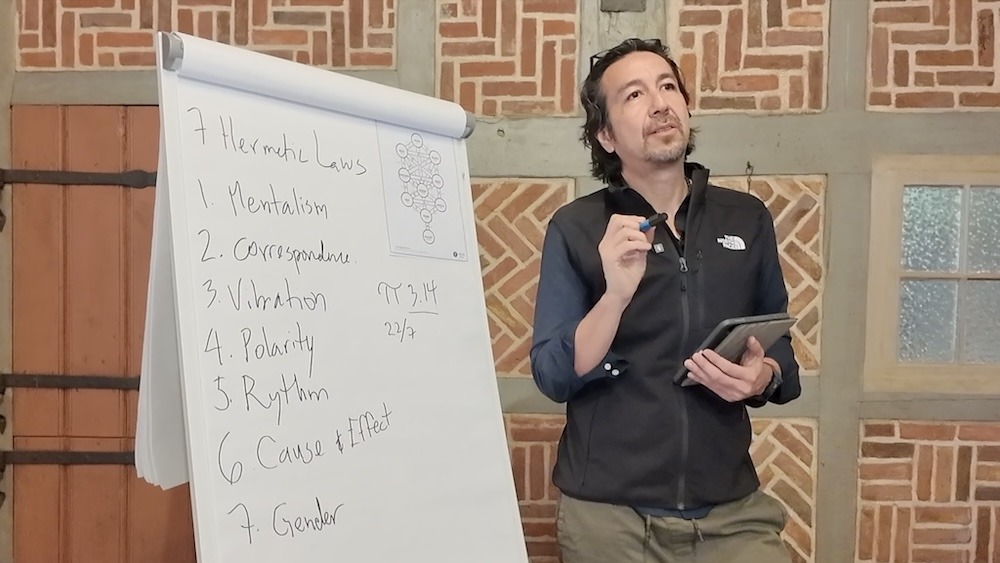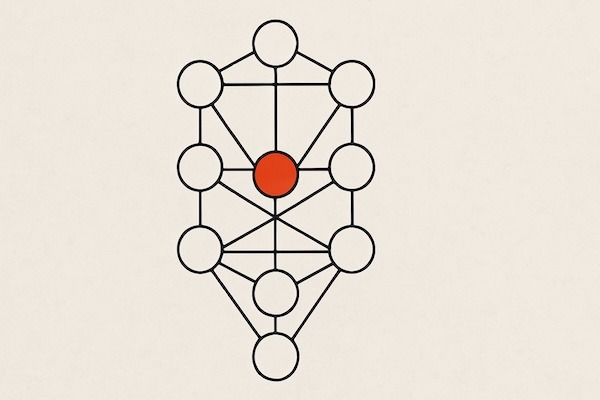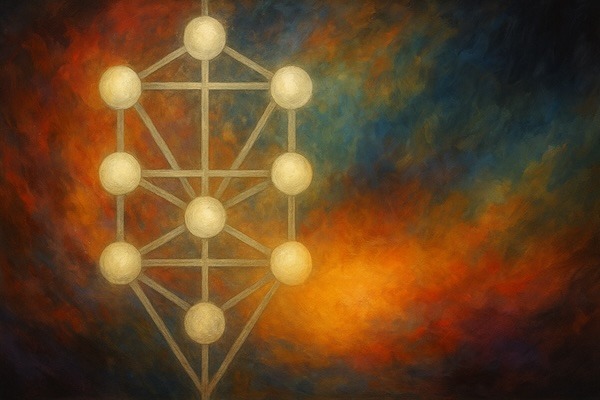A Central Sephirot that Connects Everything
Within the Tree of Life, Tiferet occupies a unique position: it is the central point of intersection between all planes of being. It lies at the geometric and symbolic heart of the tree, acting as an axis of integration between the higher forces of the soul and the embodied experiences of daily life. Its importance is not only structural but also energetic: in astrological terms, Tiferet corresponds to the Sun, the king of stars, source of light, vitality, truth, and coherence. Just as the Sun organizes and gives meaning to the solar system, Tiferet organizes the soul’s structure, allowing the other sephirot to function in balance.
The Sun is also a symbol of the luminous self, of the inner center that radiates without imposing, that shines without blinding. Tiferet represents this same quality in the psyche: a centered self that harmonizes opposites, holds tensions, and expresses itself with truth. To understand Tiferet is, therefore, to understand the intimate architecture of the human soul and its path of self-realization.
This document offers a reading from the perspective of transcendent and integrative psychology of Tiferet, its imbalances, and its value as the core of the process of self-discovery and expansion of inner potential. It is aimed at therapists, guides, and facilitators who wish to integrate the wisdom of Kabbalah into their practices of transformation, healing, and spiritual development.
1. Tiferet as the Structural Core of the Self
Tiferet (תפארת), literally meaning beauty or harmony, embodies in deep psychology the authentic self: the point of balance between shadow and light, between emotion and reason, between instinct and consciousness. It is the part of us capable of articulating our inner world with the outer world without losing integrity. It is not an illusory or idealized self but a conscious presence that has passed through pain, judgment, contradiction, and doubt and has remained standing.
From a therapeutic perspective, it represents:
- The integrated self that can recognize itself honestly.
- A non-reactive identity, free from masks.
- The psychospiritual center of the healthy adult, capable of holding paradox without dissociation.
- The bridge between soul and personality, through which our potential manifests.
It is located on the vertical axis of the Tree, connected both to the divine (Keter) and the embodied (Malkhut), and is traversed horizontally by the poles of Chesed (loving expansion) and Gevurah (boundaries). Tiferet synthesizes without neutralizing, harmonizes without suppressing polarities. From its center, the impulse toward the flourishing of being emerges.
2. The Adult Who Dwells in Tiferet
From a therapeutic and mystical perspective, Tiferet represents the transition from emotional childhood to psychic and spiritual maturity. It is the dimension where identifications with wounded past dissolve and where a subjectivity arises that is no longer defined by lack or external approval but by resonance with the soul.
The person who dwells in Tiferet no longer acts from the wound or the need to belong but begins to act from non-negotiable inner truth. Not from what the environment expects, but from a deep listening to their own heart.
Tiferet is the territory of the spiritual and psychological adult. An adult who:
- Can hold solitude without falling into a sense of abandonment.
- Recognizes their gifts without inflating or hiding them.
- Tolerates uncertainty without dissolving.
- Takes responsibility for their light and shadow, without disassociating either.
This vital center does not deny human contradiction; it embraces it. And from that emotional complexity, the possibility of living with coherence and expressing the latent potential of the soul emerges.
3. Common Imbalances in Tiferet
The main imbalances observed in this sephirah include:
- The weak self: difficulty sustaining identity without external validation.
- Distorted self-perception: seeing only flaws, denying virtues.
- Over-identification with the wound: identity based on trauma or victimization.
- Compensatory narcissism: false self-esteem that hides self-nullification.
- Fear of one’s own light: the sense that shining brings rejection or punishment.
These imbalances deeply affect a person’s ability to act with coherence and often lead to symptoms such as existential anxiety, emotional dependency, inner emptiness, chronic guilt, and self-sabotage.
From the perspective of transcendent psychology, these imbalances reveal a disconnection between the self and its spiritual center. This is not merely “low self-esteem” but an alienation from the soul.
4. Recognition of Virtue as a Therapeutic Axis
A key to working with Tiferet is the conscious and balanced recognition of one’s own virtues. This involves working with individuals who:
- Do not believe they deserve to be seen in their light.
- Minimized their talents to adapt to family or social expectations.
- Feel comfortable receiving criticism but uncomfortable with praise.
A pivotal question in this process is:
“When people speak badly of me, I listen. Why don’t I when they speak well?”
This paradox reveals an inner structure that identifies with guilt but rejects worthiness.
The therapeutic task is to open a space where the person can see—without shame or grandiosity—the good and the beautiful that dwells within them. Virtue is not arrogance; it is a form of presence. And the soul only realizes itself when it can express its potential.
5. Self-Perception: The Channel Between Binah and Tiferet
Tiferet is connected to Binah (the sephirah of understanding) through the channel of the Hebrew letter Ayin (ע), which means eye. This suggests that how we see ourselves is determined by the mental structure that inhabits us.
When Binah is balanced, it allows us to perceive ourselves with compassion and clarity. When imbalanced, it may impose a cold judgment, based on duty, guilt, or convenience. Rational mind then blocks the truth of the heart.
It is common to find individuals who:
- Interpret virtues as flaws (“being sensitive is weakness”).
- Make decisions based on what’s “right” rather than what’s “true.”
- Live from convenience rather than authenticity.
Tiferet becomes ill when subordinated to an authoritarian Binah. For this reason, the therapeutic task is to restore the heart’s truth as the guiding principle of life.
6. Radical Honesty: Medicine for the Soul
Access to Tiferet’s inner peace is only possible through radical honesty: the capacity not to lie to oneself. This virtue is not a moralistic demand but a profound act of self-care. Radical honesty allows one to recognize:
- When they are acting from fear instead of love.
- When a convenient lie fragments them.
- When their soul is speaking, even if the external world contradicts it.
Lies—even when socially functional—create a rupture between soul and personality, often reflected in anxiety, emptiness, or somatization. Only by inhabiting a non-negotiable truth can Tiferet’s inner coherence be restored.
From the perspective of transcendent therapeutic work, this principle can be applied in processes where a person must reorient toward their soul’s vocation, recover their inner compass, and begin to live a life aligned with meaning.
7. Tiferet as a Map for Personal Transformation
Working with Tiferet in therapeutic or spiritual contexts allows us to:
- Identify fractures between the real self and the adapted self.
- Explore the internal value systems that were inherited or imposed.
- Reclaim the center of personal power without confusing it with egocentrism.
- Accompany processes of individuation, reinvention, or spiritual awakening.
- Facilitate the expression of the soul’s latent potential, allowing the person to shine from their truth.
Tiferet is the point where the soul takes the reins of the psychic life, and where true inner freedom is forged. It is the space where one lives with an open heart and ego in its place—at the service of being, not in its place.
Conclusion
Tiferet is the heart of the Tree of Life and the heart of deep therapeutic process. It is where real integration occurs, where coherence is reestablished, and where the self can finally rest in itself without needing to act, defend, or justify.
Working with this sephirah means accompanying the person in their return to truth—not as an idea but as a living experience. It is helping the client remember who they are—and that this remembrance is not a theory, but a presence. Above all, it is guiding them to unleash their potential, their virtue, and their light, without fear of their own greatness.
Practical Application
This document may be used as:
- A framework for analysis in integrative and Transcendent Psychology applications.
- A foundation for self-discovery sessions guided by the Tree of Life.
- A guide for personal transformation processes centered on identity, vocation, authenticity, or existential crisis.
- A module within trainings in transcendent psychology, ancestral wisdom, therapeutic guidance, or applied spirituality.







